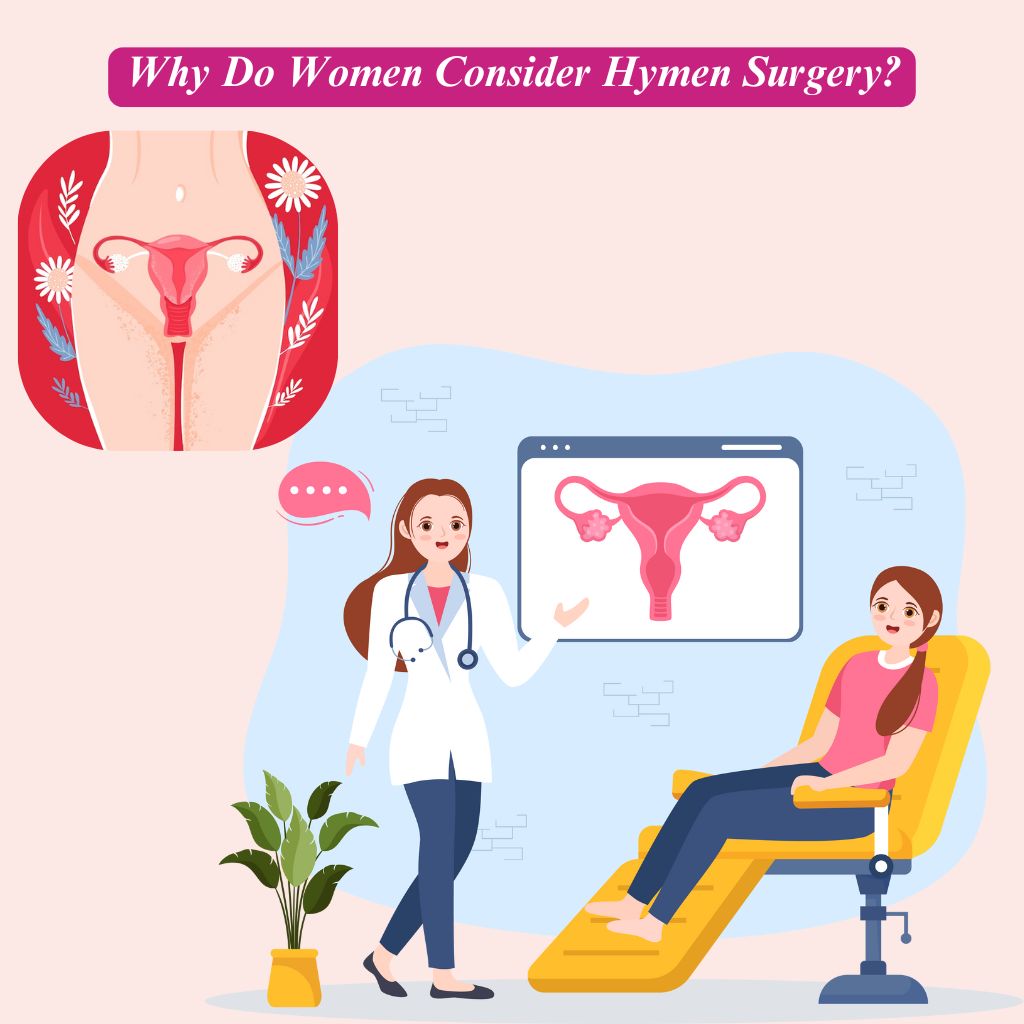Introduction
The hymen is a thin, flexible membrane that partially covers the vaginal opening. While often linked to virginity, it is important to understand that the hymen’s function is not to determine a person’s sexual history. In reality, it can naturally stretch or tear due to activities such as sports, medical conditions, or tampon use.
Hymen surgery, also known as hymenoplasty surgery, is a medical procedure designed to reconstruct the hymenal tissue. The reasons for undergoing this surgery vary. Some individuals opt for it due to personal beliefs, while others may require it for medical reasons or to address cultural expectations.
What is Hymenoplasty?

Hymenoplasty is a surgical procedure that reconstructs or restores the hymenal tissue. It is performed for medical, personal, or cultural reasons, often by a qualified gynecologist.
During the procedure, the remaining hymenal tissue is carefully sutured together, or a biological membrane is used to create a new hymen-like structure. The goal is to restore the appearance of an intact hymen without causing significant discomfort.
How Does Hymenoplasty Work?
The procedure is minimally invasive and typically performed under local or general anesthesia. It involves:
- Assessment: The doctor examines the vaginal area to determine the best approach.
- Reconstruction: The existing hymenal tissue is stitched together using dissolvable sutures, or an artificial membrane is placed.
- Healing Period: Full recovery takes a few weeks, with minimal discomfort.
Hymenoplasty vs. Other Procedures
| Procedure | Purpose | Who It’s For |
| Hymenoplasty | Restores the hymen | Those seeking hymen reconstruction for personal, cultural, or medical reasons |
| Hymenectomy | Removes the hymenal tissue | Women with a thick or imperforate hymen causing discomfort |
| Hymen Repair Without Surgery | Involves non-surgical methods like laser therapy or synthetic membranes | Individuals looking for temporary or alternative options |
Why Do Women Consider Hymen Surgery?

Women choose hymen surgery for a variety of reasons, ranging from medical conditions to personal and emotional considerations. While the procedure is often associated with cultural beliefs, it is also a gynecological procedure that can address specific health concerns.
Medical Reasons for Hymen Surgery
Certain hymenal abnormalities can cause pain and discomfort, making hymenoplasty surgery a medical necessity. Some of these conditions include:
- Imperforate Hymen: When the hymen completely covers the vaginal opening, preventing menstrual flow and causing pain and infections.
- Microperforate Hymen: A small opening in the hymen that makes tampon use or intercourse painful.
- Septate Hymen: A hymen with an extra band of tissue, which may require surgical removal.
Women who experience these conditions often opt for hymenoplasty surgery in Mumbai to improve their women’s health and overall well-being.
Personal Reasons for Hymen Surgery
For some women, hymen surgery is a personal decision based on cultural, religious, or social expectations. In many societies, an intact hymen is considered a symbol of virginity, leading women to seek the procedure for social or marital reasons. Others undergo the surgery for self-confidence or personal choice, with the desire to restore virginity before a significant event.
Psychological and Emotional Considerations
Beyond the physical aspects, the procedure has a psychological impact on many women. Some may experience anxiety before the procedure, while others find a sense of relief and emotional healing afterward. Hymenoplasty before and after results can boost self-esteem, particularly for individuals recovering from trauma or past experiences.
While hymenoplasty surgery is a private and personal decision, consulting a qualified gynecologist ensures that women receive the right medical advice and support throughout the process.
How is Hymen Surgery Performed?

Hymen surgery is a gynecological surgery that involves reconstructing the hymenal tissue to restore its structure. It is a safe, minimally invasive procedure performed under medical supervision. The process includes preparation, surgery, and post-operative care, ensuring patient comfort and safety throughout.
Preparation for the Procedure
Before undergoing virginity repair surgery, patients must follow specific pre-surgery guidelines to ensure a smooth and successful operation.
- Medical Consultation: A gynecologist evaluates the patient’s health and discusses the procedure, recovery, and expectations.
- Pre-Surgery Tests: Blood tests and other medical screenings may be required to assess the patient’s overall health.
- Fasting Requirements: Depending on the type of anesthesia, patients may need to avoid eating or drinking for a few hours before surgery.
- Hygiene Instructions: Proper intimate hygiene is essential to prevent infections and ensure a safe surgical environment.
Step-by-Step Surgical Process
The hymenoplasty procedure is performed under local or general anesthesia to ensure a pain-free experience. The surgery takes about 30 to 60 minutes, and the steps typically include:
- Anesthesia Administration: The doctor determines whether local anesthesia (numbing only the area) or general anesthesia (patient is asleep) is best.
- Hymen Reconstruction: The remaining hymenal tissue is carefully stitched together using dissolvable hymenoplasty stitches, or a biological membrane is placed if the tissue is absent.
- Final Adjustments: The surgeon ensures that the newly formed hymenal tissue appears natural and intact before completing the procedure.
What to Expect Immediately After Surgery
After hymen surgery, patients are monitored in a recovery room before being discharged. Key post-surgical instructions include:
- Mild Discomfort: Some swelling and light bleeding are common but usually resolve within a few days.
- Rest and Care: Patients are advised to avoid heavy physical activity for a few weeks.
- Medication & Hygiene: Doctors may prescribe pain relief and antibiotics to aid healing and prevent infections.
- Follow-up Appointments: Regular check-ups ensure the healing process is progressing as expected.
Most women resume normal activities within a few weeks, with full healing taking about six weeks.
Recovery and Aftercare

After hymenoplasty surgery, proper post-surgery care is essential for faster healing and maintaining vaginal health. Most women recover within a few weeks, but following medical advice ensures a smooth and complication-free recovery.
Healing Timeline
The recovery process varies from person to person, but most women heal within 4 to 6 weeks. During this time, the hymenal tissue gradually heals, and the stitches dissolve on their own.
- First Few Days: Mild swelling, discomfort, and light bleeding may occur.
- One Week Later: Most symptoms start to improve, and walking or light activities become easier.
- Two to Four Weeks: The area continues to heal, and the risk of infection reduces.
- After Six Weeks: Complete healing is expected, and normal activities can be resumed.
Dos and Don’ts After Hymenoplasty
To ensure proper healing, it is important to follow certain precautions.
Things You Should Do:
Keep the area clean and dry to prevent infections.
- Take prescribed medications as directed.
- Wear loose, comfortable clothing to avoid pressure on the area.
- Attend follow-up appointments to monitor healing.
Things to Avoid:
- Strenuous activities, including exercise or heavy lifting for at least four weeks.
- Sexual intercourse until the doctor confirms full recovery.
- Using tampons or inserting anything into the vagina during healing.
- Soaking in baths, swimming pools, or hot tubs until cleared by the doctor.
When to Consult a Doctor?
While hymenoplasty before and after results show a smooth healing process for most women, some may experience complications. Seek medical attention if you notice:
- Persistent bleeding beyond the first few days.
- Severe pain that does not improve with prescribed medication.
- Unusual discharge, foul smell, or signs of infection.
- Excessive swelling, redness, or fever.
Following these post-surgery care guidelines helps in faster healing, ensuring that the results of hymenoplasty surgery are as expected.
Risks and Complications of Hymenoplasty

While hymenoplasty surgery is a safe procedure when performed by a skilled specialist, like any surgical procedure, there are potential side effects and risks. Understanding these can help individuals make informed decisions and take steps to minimize complications.
Common Side Effects
Most women experience mild, temporary side effects that improve within a few days:
- Swelling and Bruising: The hymenal tissue healing process involves slight inflammation, which reduces naturally over time.
- Mild Pain or Discomfort: Some women may feel a pulling or tight sensation, but this can be managed with prescribed pain relievers.
- Light Bleeding: A small amount of spotting may occur, especially during the first week after surgery.
Rare Complications
While complications are uncommon, they can occur if proper post-surgical care is not followed:
- Excessive Bleeding: If there is significant blood loss, medical attention is required.
- Infection: Signs include persistent swelling, pain, fever, or foul-smelling discharge.
- Scarring: Rarely, improper healing may cause excess tissue formation, which could require medical intervention.
- Delayed Healing: Some individuals may take longer to heal due to factors like pre-existing health conditions or improper care.
How to Minimize Risks and Ensure a Safe Procedure?
- Choose a Qualified Surgeon: A well-trained gynecologist specializing in hymenoplasty surgery reduces the risk of complications.
- Follow Post-Operative Instructions: Avoiding strenuous activities, swimming, or inserting tampons helps in faster recovery.
- Maintain Hygiene: Keeping the area clean and dry prevents infections.
- Attend Follow-Up Appointments: Regular check-ups ensure the hymenoplasty stitches are healing properly.
Does Hymen Regenerate After Surgery?
The hymenal tissue does not naturally regenerate once torn, but hymenoplasty surgery reconstructs it in a way that mimics its original structure. The new hymenal tissue healing process allows it to regain a natural appearance.
By understanding surgical complications and taking the right precautions, women can ensure a safe and smooth recovery after hymenoplasty surgery.
Cost of Hymen Surgery in India

Understanding the financial aspects of hymenoplasty surgery is crucial for those considering the procedure. The cost of hymen surgery in India varies based on several factors, including location, hospital reputation, and the surgeon’s expertise.
Factors Affecting Cost
- City-Wise Cost Variation
The expense of hymenoplasty surgery differs across major Indian cities. Here’s a comparative overview:
| City | Cost Range (INR) |
| Mumbai | 25,000 – 90,000 |
| Delhi | 20,000 – 80,000 |
| Bangalore | 20,000 – 75,000 |
| Hyderabad | 15,000 – 70,000 |
| Chennai | 18,000 – 65,000 |
| Pune | 15,000 – 60,000 |
| Kolkata | 15,000 – 50,000 |
- Influence of Hospital Reputation and Surgeon Expertise
- Hospital Reputation: Established hospitals with advanced facilities may charge higher fees due to superior infrastructure and care quality.
- Surgeon Expertise: Surgeons with extensive experience and specialized skills in hymenoplasty surgery often have higher consultation and procedure fees.
Does Insurance Cover Hymenoplasty?
In India, hymenoplasty surgery is typically classified as a cosmetic procedure. Consequently, most health insurance policies do not cover the costs associated with this surgery. Patients are usually required to bear the expenses out-of-pocket. It’s advisable to consult directly with insurance providers to understand the specifics of coverage.
Is Hymen Surgery Detectable?

Many women considering hymen surgery often wonder whether the procedure can be detected by a doctor or partner. The results of hymenal restoration depend on various factors, including surgical technique, healing process, and individual anatomy.
Can a Doctor or Partner Detect Hymenoplasty?
- Medical Examination: A highly trained gynecologist may be able to detect hymenoplasty surgery if they specifically examine the area. However, since the hymenal tissue naturally varies in shape and thickness, it is not always obvious.
- Partner Detection: In most cases, partners cannot tell the difference between a surgically restored hymen and a natural one, as the vaginal structure remains unchanged.
Does Hymenoplasty Mimic a Natural Hymen?
The goal of hymenoplasty surgery is to restore the hymen in a way that closely resembles its natural structure. However, there are a few key differences:
| Feature | Natural Hymen | Surgically Restored Hymen |
| Appearance | Varies in shape and thickness | Carefully reconstructed for a natural look |
| Elasticity | Can stretch or tear over time | Designed to mimic natural elasticity |
| Healing | Does not regenerate once torn | Stitches dissolve and allow healing |
| Detection | May not always be intact | Generally undetectable without close medical examination |
Does the Hymen Regenerate Naturally?
The hymenal tissue does not regenerate once torn. However, hymen surgery can effectively restore its appearance. The procedure involves using existing tissue or a thin biological membrane to reconstruct the area, making it indistinguishable from a natural hymen in most cases.
For women considering hymen surgery, it is essential to consult a qualified gynecologist to discuss expectations, healing outcomes, and any concerns regarding detection.
Alternatives to Hymenoplasty

While hymenoplasty surgery is a popular option for hymenal restoration, some individuals prefer non-surgical alternatives. These approaches focus on physical, emotional, and gynecological health, offering solutions without requiring medical intervention.
Non-Surgical Options for Hymen Repair
- Pelvic Floor Therapy
- Strengthening the pelvic muscles can improve vaginal tone and elasticity, which may enhance comfort and confidence.
- A specialized physiotherapist can guide women through targeted exercises to support gynecological health.
- Psychological Counseling
- For women considering hymen repair without surgery due to emotional or societal concerns, therapy can provide guidance and support.
- Counseling helps address societal pressures, personal anxieties, and self-esteem issues linked to hymen function.
- Synthetic Hymen Kits
- Some products mimic the appearance of an intact hymen, releasing a blood-like substance when broken.
- These are temporary solutions and do not provide long-term results.
Does the Hymen Regenerate Naturally?
The hymenal tissue does not regenerate once torn. However, many women are born with flexible hymens that do not break even after physical activity or intercourse. In such cases, hymenoplasty surgery may not be necessary.
When is Hymenoplasty Not Necessary?
- If the hymen remains intact despite intercourse, surgery may be unnecessary.
- Women experiencing pressure from cultural beliefs may benefit from counseling rather than medical intervention.
- If the goal is personal confidence rather than medical necessity, alternative approaches may be explored.
For those unsure about surgical vs. non-surgical options, consulting a gynecologist can help determine the best treatment plan.
FAQs
Q1: What is the purpose of the hymen?
Ans: The hymenal tissue is a thin membrane partially covering the vaginal opening. It does not serve a major biological function but may help protect the vaginal canal from infections during infancy.
Q2: What happens when the hymen breaks?
Ans: The hymen can stretch or tear due to various activities, including exercise, tampon use, or sexual intercourse. Some women experience slight bleeding, while others do not notice any changes.
Q3: Is hymenoplasty surgery painful?
Ans: Hymenoplasty surgery is performed under local or general anesthesia, so the procedure itself is painless. Some mild discomfort, swelling, or light bleeding may occur during recovery, but it typically subsides within a few days.
Q4: How long does hymenoplasty take?
Ans: The surgical procedure usually lasts 30 to 60 minutes, depending on the complexity of the repair. Patients are often discharged on the same day with post-surgical care instructions.
Q5: Can the hymen naturally repair itself?
Ans: No, the hymenal tissue does not regenerate once torn. However, hymen surgery can reconstruct it to restore its appearance.
Q6: What is the best age for hymenoplasty?
Ans: There is no specific age requirement, but most women undergo vaginal surgery for hymenal restoration after 18 years of age when they are legally able to consent to the procedure.
Q7: Can I have sex after hymen surgery?
Ans: Doctors recommend waiting at least six weeks before engaging in sexual activity to allow for proper healing. Engaging in intercourse before complete recovery may affect the results.
Q8: Will my partner know if I had hymenoplasty?
Ans: In most cases, hymenoplasty before and after results make it difficult to detect the difference between a natural and surgically repaired hymen. A partner is unlikely to notice.
Q9: Are there any permanent side effects?
Ans: When performed by a qualified gynecologist, hymen surgery is considered safe with minimal risks. However, if not done correctly, there may be complications such as scarring or prolonged discomfort.
Q10: Where can I find the best gynecologist in Mumbai for hymenoplasty?
Ans: Women seeking hymenoplasty surgery in Mumbai should consult an experienced gynecologist at a reputable women’s health clinic for safe and effective results.


